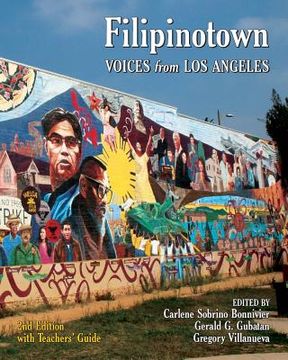Reseña del libro "Filipinotown: Voices from Los Angeles (en Inglés)"
We're in the 1930s and 40s, Downtown L.A. We're with the Filipino "boys," hanging out on Bunker Hill. John Fante (Chapter 15 - McWilliams) has a rented room in one of the old Victorian houses there, and it's just a few blocks to the Chinese and Filipino restaurants on Temple and Figueroa. He's friends with William Saroyan (Chapter 14) and Carlos Bulosan (Chapters 3 4, 9, and 12 - Carter and Bonnivier). An Italian, an Armenian, and a Filipino. All great writers, all outcasts, the three of them eating chicken adobo, white rice, and pancit noodles. Lots of garlic. Highballs in smoke-filled bars. Across the street to the pool hall. Heavy betting. Royalty checks to spend in a weekend. The "boys" from the Islands were also found near Roseland (Chapter 25 - Bejarano) and other taxi dance halls near the rooms they rented around First and Main in "Little Manila" which overlapped "Little Tokyo." In 1942, President Roosevelt signed Executive Order #9066, approving the internment of 120,000 Japanese-Americans on the West Coast, alleging that they threatened national security. In protest, a young Mexican man named Lazo (Chapter 17 - Rasmussen), from Belmont High School (not far from Bunker Hill), accompanied his friends to Manzanar. He stayed for about two years, and would no doubt have stayed to the very end but was drafted out of Manzanar into military service and was soon fighting in the Philippines. (More than 80,000 of the 200,000 Filipinos in the Islands whom President Roosevelt ordered into active duty died during the war. (Chapter 8 - Gaulke, de la Cruz, Bonnivier)). In the 30s and 40s in California (and elsewhere) Filipinos could not own property, have a business, or marry non-Filipinos, even though the ratio of Filipino men to Filipino women was about 15:1. At this time the only labor union open to Filipinos was the Brotherhood of Sleeping Car Porters (Chapter 18 - Grace & Bonnivier). Chauffeurs, houseboys, cooks, field workers, dishwashers as political activists? Well, they might get fired or even killed, or they might have run-ins with the FBI (Chapter 9 - Hirabayashi and Alquizola). The 50s brought peace and at least the possibility of prosperity to the people who lived along Temple Street (Chapter 25 - Bejarno). Then followed the turbulent 60s and early 70s during which time immigration laws opened up, and new waves of well-educated professional Filipinos arrived (Chapter 30 - Cablayan). Some came to stay (Chapter 28 - Geaga-Rosenthal). For decades, Filipinos had shared their lives with Mexicans and other people of color, working in the fields or living in inner city neighborhoods. The formation of a union for farmworkers (Chapters 3 - Bulosan; 9 - Hirabayashi and Alquizola; 38 - Silva), was initiated by Itliong and Vera Cruz, and then championed by Chavez. It's now the 1980s-1990s, and we see "the boys" who came here in the early 1900s have either passed on or are old men. They have become our revered and sometimes overly-romanticized elders (Chapter 36 - Brainard). 21st Century: The two youngest contributors to our collection (aged 17 and 23) meet at our writing workshop at the Echo Park Library. It turns out they are from the same pueblo, San Juan, in Mexico. 2014: Our oldest contributor is Henrietta Zarovsky. She is Jewish-German-Russian and was 13 years old when her family moved to Bunker Hill in 1935 (Chapter 16), a few blocks away from the Central Library where Fante and Bulosan were busy making literary history.

